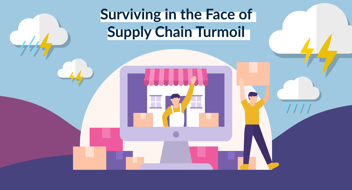CEO Corner: The AI Hype is Noise
Every week, it’s a new headline: AI is disrupting retail! AI is rewriting your website! AI is choosing your next product line!
The digital noise around Artificial Intelligence has reached a fever pitch. CEOs are scrambling to invest, terrified of being left behind. They’re launching working groups, buying complex tools, and spending millions of dollars trying to solve tomorrow’s hypothetical, high-tech disruption.
But I'll let you in on a secret that your Head of Supply Chain already knows: For 90% of brands right now, the most powerful and transformative AI they could possibly implement isn't some complex, generative language model.
It’s the simplest form of intelligence: Knowing precisely what is selling, where, and when.
Your expensive AI stack isn’t failing because it lacks quantum processing power; it’s failing because it’s being fed garbage data, or worse, incomplete data. You’ve built a brilliant brain, but you’ve only connected one eye.
The Fiction of the Forecast: A Case of Retail Amnesia
For decades, brands have relied on a forecasting system built on a half-truth that generates maximum inefficiency. We aggregate data from our DTC site, we analyze wholesale orders (which are just retailer best guesses, often placed months in advance), and we look at historical trends from our own warehouses. We then feed this mush into planning software and call it a prediction.
This is fundamentally flawed. It's retail amnesia—forgetting the critical point of sale.
When a product sells out at one of your independent retailers in Austin, Texas, what do you know about it? Absolutely nothing that matters in real-time.
- Do you know if the store sold out yesterday, or three weeks ago?
- Do you know if the consumer actually wanted the red one but had to settle for the blue one because that was all the store had left?
- Crucially, does your main fulfillment system even know this inventory is gone, or is it still showing up as "available stock" in some forgotten corner of your ERP?
If your answer is "no" to these questions, then your entire AI infrastructure, no matter how clever or expensive, is flying blind. It’s operating only on ship-out data (what you sold to the retailer), not sell-through data (what the retailer sold to the consumer). You are making million-dollar decisions based on a historical invoice, not a real-time demand signal.
Sell-Through Data Is The New Gold Standard for Practical AI
The most practical, profitable application of intelligence in retail isn't to write an email subject line; it's to master inventory intelligence and fulfillment optimization.
This is where the rubber meets the road. When a brand can integrate live, transactional sell-through data from its entire network of partners (physical stores, independent retailers, and e-tailers) the game changes. You stop guessing and start knowing.
This immediate, network-wide intelligence unlocks true operational AI utility:
- Demand Sensing & Allocation: Your system stops waiting for the next quarterly order and starts reacting to actual consumer purchase signals the moment they happen. You can proactively push inventory to the locations with the highest real-time velocity, maximizing sell-through and preventing costly, margin-killing markdowns in slower regions.
- Optimized Fulfillment: If your system knows a customer in Portland just bought the last pair of boots from your partner store two suburbs over, it can dynamically reroute the next online order from the closest inventory source that isn't a selling floor, minimizing shipping zones, reducing costs, and cutting transit time from five days to two.
- Smarter Reordering: You can move past the archaic quarterly Purchase Order process. You can instantly understand which of your partners needs restocking today, preventing both catastrophic stock-outs and expensive inventory bloat across the entire distribution map.
The Intelligence Investment You Can't Afford to Skip
The ultimate inefficiency in modern commerce is the data silo that exists between the brand and the final point of sale. This silo is a tax on every area of your business: it increases working capital requirements, inflates shipping costs, necessitates higher safety stock, and, worst of all, creates friction for the consumer.
So, before you greenlight the next multi-million-dollar "AI Transformation" project, ask your team this simple question: Do we have real-time access to our sell-through data across our entire partner network?
If the answer is anything less than a resounding "yes," that should be your only priority. You need the infrastructure that closes the data loop between the brand and the cash register. Without that, you’re just feeding your new, expensive AI models the same old, stale information, hoping for a miracle.
The best use of intelligence is to remove inefficiency and waste. And right now, the greatest inefficiency is the fundamental lack of connection between those who make the product and those who actually sell it. Focus on fixing the plumbing first.
Oh, by the way, building that seamless, single connection between a brand’s supply chain and its entire retail partner network? That's precisely what we do here at Quivers. It turns out that fixing the plumbing is the smartest AI investment you can make.




